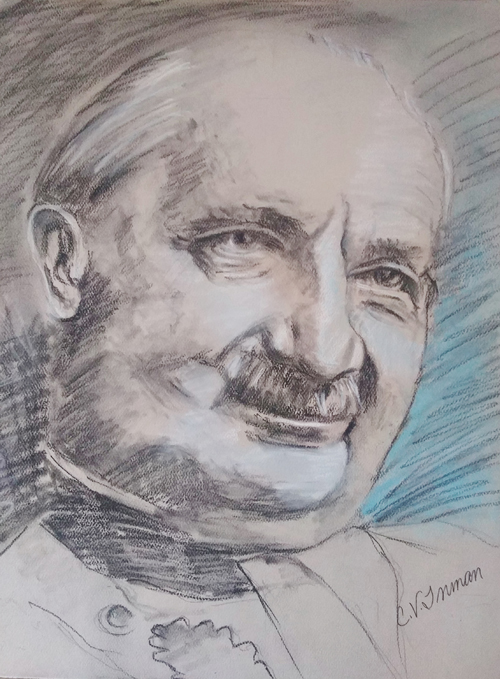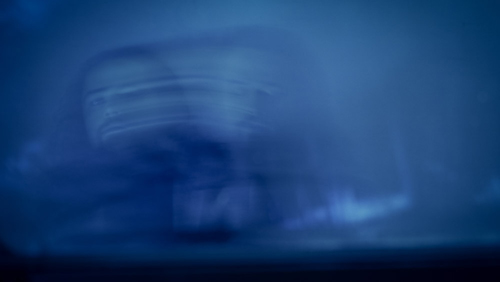
Your complimentary articles
You’ve read one of your four complimentary articles for this month.
You can read four articles free per month. To have complete access to the thousands of philosophy articles on this site, please
Existentialism & Life
We’re All Existentialists Now
Greg Artus contemplates (dis)embodiment, Zoom life and social media, through the ‘Looks’ of Sartre, Heidegger, and Merleau-Ponty.
In this past year of severe restrictions on physical social interaction, everyone seems to have been made starkly aware of the importance of what some existentialists would call Being-with-Others. A social life conducted through screens has shown people how impoverished life is without the physical presence of others. The popular expression of this has been through the language of ‘hugs’: everyone talks of missing hugs and other physical contact.
People seem surprised by the way this lack of other bodies has affected us. Perhaps this is because before this year of disembodied socialising we had been seduced by a view of ourselves as primarily minds who interact with one another through language and ideas. This view has dominated Western thought at least since Descartes, but perhaps even since the ancient Greeks. On such a view, it should not matter whether the interaction occurs in person or through a screen, since the body plays no essential part in the exchange of ideas and feelings. If both language and ideas are abstract, non-physical, then communication shouldn’t be affected by one’s bodily presence. Yet we have found that it is affected. We have found that we miss the bodily presence of others more than our dominant paradigm suggests we should.
However, phenomenology and its offspring existentialism together provide a stream of philosophy in which various thinkers have emphasised the role our embodiment plays, and it can be argued that the past year has provided ample experiential evidence they’re right. So a comparison between the thinking of prominent practitioners Martin Heidegger, Jean-Paul Sartre, and Maurice Merleau-Ponty, may not only help us understand why we have felt so bereft at having to live our lives through screens, but also provide us with insight into why online life is so different from real life, and even explain some of the more toxic aspects of life lived through the social media lens.

Martin Heidegger by Clinton van Inman
Portrait © Clinton Inman 2021 Facebook at Clinton.inman
The Look of Life
Let’s start with Sartre’s exploration of how the ‘Look of the Other’ is constitutive of our self-consciousness. He says it forces us to step back from what we’re doing and reflect upon ourselves as the object of another’s appraisal.
Sartre developed his discussion of ‘the Look’ because he was unhappy with Heidegger’s conception of our fundamental existential condition as Mitsein, translated as With-Being or Being-with-Others. For Heidegger in Being and Time (1927), Others – other people – are present in or a given with every experience we have. The meaning we see in everything is shot through with the presence of Others, such that Others are constitutive of our very Being. For example, just to see a pen is to see an entire world of other consciousnesses, because it is to see a world of language, of writing, of communicating, of teaching, of making notes and recording, of manufacturing, of industry, of commerce… it is, to borrow a phrase from Ludwig Wittgenstein, to see an entire form of life – a world constituted by ‘Us’. Heidegger sees this presence of Others in all our experience as proof against the Cartesian solipsistic possibility that we can doubt the consciousness of others – the so-called ‘problem of other minds’. For Heidegger, Others are the ground and condition of our every conception of the world, and thus constitutive of our very Being. We simply could not experience the world as we do if there were not other conscious beings with whom we have created our world of meanings, so our world is a With-World. Being is Being-With.
In Being and Nothingness (1943), however, Sartre argues that this account is not enough to overcome the problem of other minds. His reasoning is that, although Heidegger has shown us that the existence of other consciousnesses is a precondition of our own Being, such an approach does not enable us to prove that any particular one of these Others is conscious. He has shown that there are other consciousnesses, but he cannot show me that you are conscious. Consequently, Sartre wants to see Others not in terms of how ‘they’ constitute of my world, but in terms of particular encounters. It is my encounters with particular, concrete, embodied Others, not an immersion in a generalised world of Others, that facilitates my self-consciousness, and hence my Being. And for Sartre, it is the Look of the Other that is central to this encounter. And what’s more, it is the Look of the embodied Other viewing my body that enables my self-reflection.
Sartre’s famous illustration of the Look is his example of the jealous lover. Suppose I am a lover who, for whatever reason, is consumed with jealousy about my lover’s activities, and so I’m spying on her through a keyhole. I am completely immersed in what I’m doing. My attention is focussed entirely outside of myself on the task in hand, and I’m not thinking about me but about the object of my attention. I am entirely unreflective; I’m just doing. In this mode, I am what Sartre calls a body-for-itself – a physically embodied doer, immersed totally in its active engagement with the concrete world of activity, focussed only on the purposes to hand. But then I notice that someone – some Other – is watching me as I spy on my lover. This Look of the Other snaps me out of my immersion and forces to me to see myself from the outside, so to speak. Under this withering Look of the Other, I am brought face to face with the fact of what I’m doing and how it must look to Others. Now I am no longer focussed outwardly on my task, but am focussed inwardly, on myself, viewing myself and my actions as another might view me. I am no longer focussed on my lover, but reflecting upon what I am doing and how it looks. Thus I become what Sartre calls a body-for-Others ; an engaged body that is an object of scrutiny and evaluation by another body-for-itself – an Other who is engrossed in watching me as I watch my lover.
Sartre does not want to say that the self-awareness I am forced into is simply one where I now just know what my action was and how it’s seen. It is rather that the Look of the Other forces me to understand myself differently ontologically, or as a different type of thing: as an object for another subject. Indeed, for Sartre, my most basic existential condition is that of a body-known-by-Others. Thus I discover myself in the Look of the Other, in that I am reflected in it in such a way as to enable self-reflection. The Look enables me to step back from what I’m doing and see myself.
This self-awareness, however, sets up a conflict within me. The conflict is the result of my trying to define my subjectivity through the objectifying gaze of Others. On the one hand, I am viewing myself through the Look of Others; but on the other hand, I am viewing myself through my own eyes. I am a subject, but also understand myself as an object for other people. I am caught between the Look of the Other and the Look of myself which their Look has enabled me to have. Hence, unlike Heidegger, for whom my relation to others is Mitsein – being-with – for Sartre, my relation to Others is one of conflict, as I try to find myself in the view they have enabled me to have of myself. This conflict is what I am.
Furthermore, for Sartre, the Look of the Other means that my fundamental condition is characterised by shame, guilt, and pride. I grasp the Look of the Other as an evaluative gaze. The reason I am forced out of myself when spying on my lover is because I know that the Look is judging me. This judgemental aspect of the Look of the Other is the source of my self-reflection, and I am ashamed to be an object to some other subject. Hence to be human is, by definition, to be fallen. To exist is to exist in shame.
As an account of the ground of self-consciousness, Sartre captures well the role of the body as constitutive of the self: to be is to be a body-as-known-by-Others. It makes self-awareness a gradual coming to be as one lives and acts under the objectifying Look of particular Others. Hence it makes self-awareness the result of being embodied amongst Others over time, engaged in bodily activity with them, rather than the result of being-with the generalised ‘Otherness’ of Heidegger. And in characteristically gloomy Sartrean style, it is a self-reflectiveness whose core is shame, guilt, pride, and conflict. The Others are detached from me, viewing me as object from a distance. They are not with me, but are simply focussing their crushing gazes upon me.

To Think

To Suffer

To Hide
Series of conceptual self-portraits by the artist Jack Clarke: “Taking inspiration from the works of Francis Bacon, I aimed at exploring self, but more importantly the emotional representation of self over the period of lockdown.” For more, visit: jackclarkeuk.myportfolio.com. Existential States © Jack Clarke 2021
Perception & Engagement
But we must ask of this picture, How do I come to see the Look of the Other as judgemental? When I’m in my garden and notice a bird, dog, or cat watching me, I don’t imagine them to be morally judging me. I am not ashamed or otherwise objectified under their gaze. Any shame I feel is shame under the Look of other human subjects. So why is the Look of other people so different from the look of mere animals? Here, I feel, Sartre’s account misses something important, and the account of Merleau-Ponty is more apposite. I will also try to show how the difference between the two accounts can tell us something important about why we missed the bodily presence of others during lockdown. It may also reveal something interesting about how the world of social media differs from the real, embodied, human world.
In The Phenomenology of Perception (1945), Merleau-Ponty develops a picture of our engagement with Others that’s closer to Heidegger’s notion of Mitsein than to Sartre’s story. It has its roots in his wider thesis that our sense perception is complex, meaningful, and transcendent.
The third of these terms is the most important for our purposes, but it will help to briefly explain the other two. By saying that our sense perception is complex, Merleau-Ponty means that we do not experience atomic units of raw data, but only experience anything at all in the context of a complex experience, for instance seeing a single colour against a background. Even a single dot on a page stands out as a dot only against the white background of the page. So, rather than taking in the world in pieces and assembling it in our experience, we actually perceive complex patterns, first on the model of figure-background. We take in whole scenes and patterns as relations between their different parts.
This naturally leads on to the next claim, that the perceptual field is experienced as meaningful. The meaning is not overlaid by us mentally after the perception, but is given in what we see. This is because, even on the basic figure-background model, any scene we experience must have an organisational unity to it: one thing is behind another; something is in the distance, or within reach … Meaning is built into what we experience through the senses.
Furthermore, our relation to the world is to something transcendent – to something that is not me. We can see this in the way we continually adjust ourselves to it: one cannot adjust oneself to something not distinct from one. Merleau-Ponty gives the example of feeling a piece of soft cloth; we adjust our touch to the task in hand and feel it gently, not grip it tightly or roughly. But there are many illustrations of our adjustment to the world. When we sit on a rickety-looking chair, we lower ourselves gingerly into it, rather than flop into it as we would a big comfy sofa; or a sound may be too indistinct for us to hear clearly, and we may have to strain to hear it; or an object may be too small to see, so we go closer; a light may be too bright for my eyes, so I squint; an object may be too heavy to easily lift, so I strain… For Merleau-Ponty, if we contemplate our experience, we can see that we are engaged with a world that is not us – one that has its own structure and direction, to which we must adapt and synchronise ourselves. The world pushes back at us, and so cannot be merely our own mental construction.
This understanding of the world’s transcendence has deep implications for our relation to other minds, in that when we engage with Others, we can take up and influence their projects, and they ours. When I converse with you (and I do mean converse, not simply question and answer: question and answer is not a conversation), I say something which changes your project, your direction of thought, which leads you to say something in response; which in turn leads me to take up this new project; and so on as we let the conversation meander, both of us along for the ride. Hence, when I engage with others, I am not merely observing their behaviour, as a Cartesian idea of us as simply minds might have us think. Rather, we shape each other’s projects, and thereby both become part of a single project which is our joint creation. I could only do this if you’re another consciousness with your own projects. So Descartes’ problem of other minds does not fit the facts. Moreover, Merleau-Ponty’s account stresses the role of our embodiment in our relations to each other. Taking up each other’s projects is often an embodied relation. So, for example, when two people dance together, they will not do it very well if they try to watch each other and follow each other’s moves on the stimulus-response model. Their dancing would be stilted and would not flow. No. To dance properly, two people must synchronise their movements into the same rhythm, as if they were both trying to harmonise with a third term called ‘the dance’, which is created by them both as a shared project. The dance exists not in either or both of them; but between them in their bodily harmony. Here to some extent, they become one.
This embodied transcendence shows itself in so many areas of our lives; in sports and games, when teams find those rare moments when they become a single, harmonious unit; in music, when a group of musicians hit the same groove, or a choir finds that perfect harmonious balance; at work, when people become completely synchronised in a single task; or in everyday life, when we walk together in silence, or gaze at the same view, or join in conversation together, or cook together, or share a joke, or simply hang out together doing very little. In all these examples, the synchronisation is not in the head – it is not mere thought – but is a bodily relation between us. And as we find the same flow, the same style, the same rhythm and tempo, the reflective mind recedes as we embrace the simple joy of synchronising with the Other, transcending each other’s subjectivity to make genuine contact with them and find solace and comfort in that oneness.
This is very different from Sartre’s world of conflict and shame, driven as it is by the Other’s remorseless, judgemental, detached Look. In embodiment, we can transcend the isolation of our subjectivity. We find each other. In this sense, Sartre’s view seems an impoverished account compared to Merleau-Ponty’s. For Sartre, the body constitutes our self-awareness only by being the object of Others’ detached gaze; whereas for Merleau-Ponty, the body plays a more complex role in shaping our self-awareness and our connection with particular people. For Merleau-Ponty the body and Others can be a source of solace and connection as well as a source of shame and objectification.
Disembodied & Detached
We can begin to see why life lived through a screen – a life that is essentially disembodied – is so different from normal, embodied human life. When conversing online, all we have are the words of others, and perhaps a view of their facial expressions; but all the other elements of a live conversation are stifled. One cannot easily read the subtle cues and signs that would normally lead to one person letting another talk, for instance. Generally, one cannot find the harmony and synchrony that a live conversation can make possible – found in the hesitant pauses, the thoughtful silences, the subtle inflections of voice and expression, the intonation, the bodily mirroring of each other’s postures, the fact that you can both be looking thoughtfully off into the same distance as you consider the next contribution to the shared conversation… A conversation develops a style, a rhythm, an atmosphere almost, which is visceral and is the consequence of being together, embodied in a shared space in a shared situation, synchronising movements and mind to transcend the gulf between you. A conversation can be intense, easy and relaxed, strident, angry, serious, flippant; but none of these things are necessarily in the words spoken, but in the way you are together. They’re not abstract, but concrete, grounded in physical relations.
Online, some of this synchrony can be retained, but so much of it is lost. It’s difficult to read the Zoom room: nobody knows quite when it’s their turn to speak, silences are not allowed, no-one really knows who’s looking at whom, there can be no quiet asides to the person next to you, no subtle signals from the tentative that they may want to speak, no synchrony of posture. It may be that this is why we've found online socialising, teaching and working so isolating in itself – because without the physically embodied presence of Others, it is all but impossible to transcend our subjectivity in the non-verbal ways normal embodied life allows. Through a screen we are unable to synchronise and find harmony and rhythm with others, so much of the joy of other people is denied to us. We’re just words and a face.
The world of social media commentary is perhaps even more alienating. Here, the conversations are not even spoken, but written. There is not even an expression to see, or a tone of voice to hear. There are no people, only words. There is no way to synchronise or harmonise with others, or transcend the gulf between us that embodied being-with makes possible. Meanings are difficult to discern because so much of the meaning and style of a conversation is carried by the embodied relation between two speakers. In this sense, a proper social media conversation is difficult, if not impossible, to have.
On social media, the exchanges usually amount to no more than statement-judgement-statement, as if everyone is reduced to being the shell of a human being rather than being an actual person. This is far closer to Sartre’s nightmare world of shame, guilt and pride under the Look of a detached and judgemental Other than it is to Merleau-Ponty’s being-with. So it would seem that the past year, in which we all have suddenly and without realising it become existentialists lamenting the lack of embodied being-with, has provided strong evidence that Sartre’s account only captures one aspect of the way our self-consciousness is grounded in our embodiment. The bare, detached Look of the Other isn’t enough. Rather, it is only because we can become bodily synchronised in shared projects together that we can come to find a common frame of reference in which the notion of judging one another can make sense. So whereas for Sartre the Look of Others is the ground of our condition of shame, for Merleau-Ponty our embodiment can also be a source of the connection, strength and succour that is necessary for human flourishing. Through our synchronous transcending of our subjectivity we can become a harmonious whole with others, and share the simple joy of being the same as others yet different. This is what we have all missed this past year, since we can do it only by being embodied in the same physical space.
This may also explain why social media exhibits its more toxic aspects. Social media is disembodied minds articulating mere words under the detached, judgemental, and baleful Look of an amorphous Other. It results in living either in pride or in shame through the detached and objectifying Look of the Other, with none of the solace, nuance, understanding, transcendence, or possibilities of connection that full-blooded, embodied being-with can provide. Sartre describes this world quite well; but the past year has shown us that Merleau-Ponty was probably closer to the truth regarding normal, embodied human existence. If Merleau-Ponty describes Being-With-Others, Sartre could perhaps be said to describe Being-Unwith-Others. The shrill, judgemental tone of so much social media would certainly seem to be a bad case of Being-Unwith-Others. It’s a fairly toxic place to be.
© Greg Artus 2021
Greg Artus is a lecturer in Philosophy at Imperial College London.









